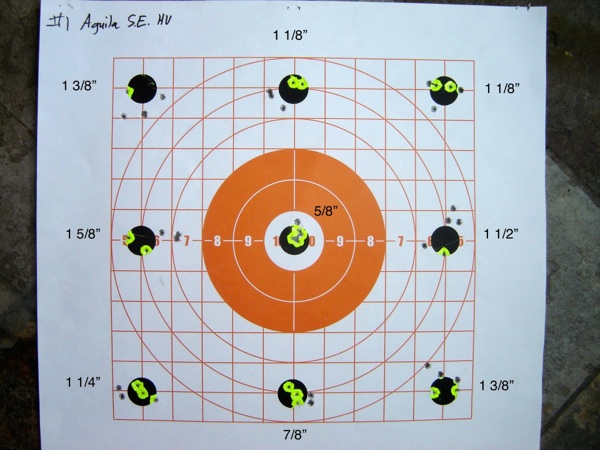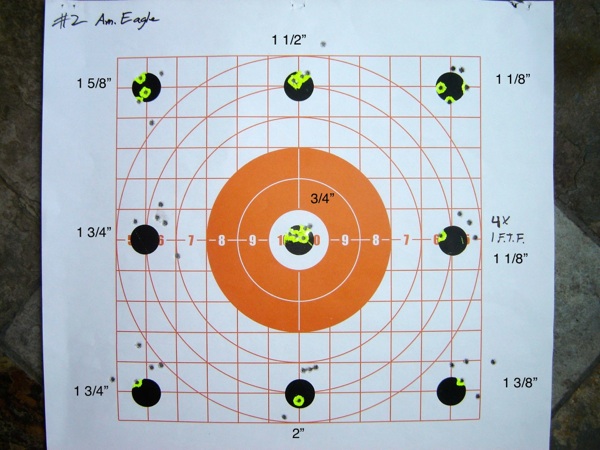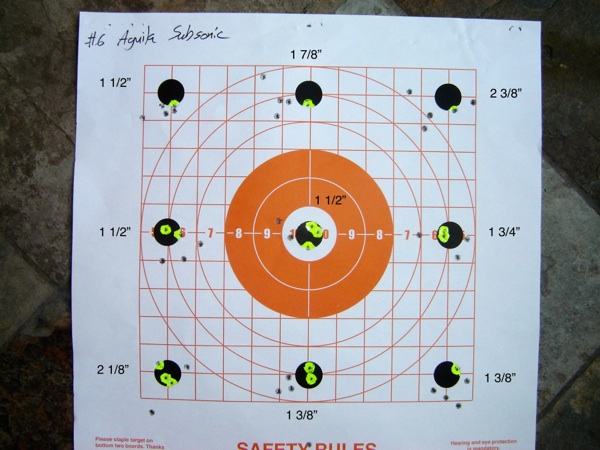Ammo Test Day #3

.22LR Ammo Test Day #3
The previous write-ups with all the explanations…
Hopefully this will be my final write-up on my ammo testing (at least until I have some significant changes to my rifle to make me do all this stuff again).
After posting up my previous two reports I had two issues brought up by folks on several different shooting forums concerning improvements to my shooting methods. Both of them seemed questionable to me as to how or why they would improve the accuracy of my shooting but since there were plenty of anecdotes supporting them they made me think about it. Since no one could point me to any actual testing of these “truisms” I thought I’d try to put both of them to the test myself and have some fun shooting in the process, of course.
Theory #1: “Hand charging the action will make the first shot less accurate than the self-charging action of the rifle, so burn the first shot of each magazine off-target.”
Interesting, and I could imagine that the bolt would not be exactly in the same place as when it would be when cycled by firing a shot, but I’m not sold on whether it really makes a difference or not.
Theory #2: “Barrels must be “well seasoned” to each particular ammo to obtain it’s true accuracy.”
In my previous tests I ran three different types of ammo back-to-back before running a bore snake through to clean it out, and I only shot three 3-shot groups (nine rounds total) per ammo. I had also run full targets worth of a single ammo before and had not noticed any change, but perhaps I just wasn’t paying attention. Does ammo really need many more shots for it to settle into a true representation of it’s performance? Call me really skeptical on this one.
I was really more interested in testing Theory #2 than Theory #1 but I figured I could get both covered in the same test, so here’s what I did…
I picked out six brands and types of ammo; five that had performed well for me in the previous tests and of which I had multiple boxes; and then one new type I had just gotten in. Since it was the same brand as two of my other five ammo types I’d thought I’d get triple-duty by testing it now.
Ammo tested (in order):
1. Aguila Super Extra - High Velocity
2. American Eagle (high velocity)
3. Blazer (high velocity)
4. Aguila Super Extra - Standard Velocity
5. CCI - Standard Velocity
6. Aguila Super Extra - Subsonic (new to the testing grounds)
For this round of testing I pulled my bore snake through two times prior to shooting each type of ammo. All shots were made using Ruger BX-25 magazines with two mags needed for each test.
I fired five rounds at a “sighter” dot at the bottom of the target to make sure I was sighted in correctly before firing the “real” shots. This was something recommended by one of the folks suggesting Theory #2.
I then shot nine five-shot groups at each one-inch dot starting in the upper left and moving right and then down one row (just like we read). In total, nine target dots with 45 shots were measured for each brand/type of ammo. Because the BX-25’s hold 25 rounds and the first five shots were at the sighter dot, the #5 dot (middle row, center dot) is the first target to be shot with the magazine change. Keep that in mind as you view the pictures.
I’ll show each picture with any related commentary as usual. I’ll also make a listing of the final measurements and conclusions at the bottom.
Here we go…
Target #1: Aguila Super Extra - High Velocity
Minimum: 5/8”
Maximum: 1 5/8”
Average: 1.21”
As you can see, the Aguila HV did very well for me as it had done in my previous test. Dot #5 was especially nice.
Target #2: American Eagle (high velocity)
Minimum: 3/4”
Maximum: 2”
Average: 1.44”
The American Eagle did OK, though not very consistent with some flyers messing up otherwise good groups. As on the previous test, I had a failure, though this time it was a failure to feed resulting in a damaged bullet tip and it bent the bullet in the casing, so Dot #6 only had four shots.
Target #3: Blazer (high velocity)
Minimum: 5/8”
Maximum: 2 1/2”
Average: 1.54”
In my previous tests the Blazer had been one of my top cheap performers, but it was not behaving as well this time and it came in 5th out of the six tested. I got caught by a cease-fire between Dot #3 and #4, so Dot #4 was hand charged and the barrel had a chance to cool for five minutes.
Target #4: Aguila Super Extra - Standard Velocity
Minimum: 3/8”
Maximum: 1 1/2”
Average: 0.88”
The Aguila SV rocked on my last test with an average group size of 0.63” and this time it didn’t disappoint. The Dot #5 is two holes at half an inch and I’m pretty sure four of the shots went through the lower hole. Unfortunately I had four FTE’s while trying to shoot Dot #4.
Target #5: CCI - Standard Velocity
Minimum: 3/4”
Maximum: 1 5/8”
Average: 1.28”
The CCI-SV seems fairly consistent although it doesn’t give me real tight groupings.
Target #6: Aguila Super Extra - Subsonic
Minimum: 1 3/8”
Maximum: 2 3/8”
Average: 1.71”
This was the new ammo for me. (I had accidentally purchased a brick from Midway thinking it was the Standard Velocity.) Since it is listed as having a muzzle velocity of 1025fps I thought it would require a bump up on the red dot elevation, but in the end it didn’t need it. As you can see, it didn’t group real well for me so I’ll probably sell off the remaining boxes. I got caught by the cease-fire in between Dot #5 and #6 but it doesn’t appear that it affected the group sizes in any way.
The official stats:
Some conclusions…
Obviously, my rifle shoots the Aguila Standard Velocity (Target #4) really well although I wish it would behave better extraction-wise. It seems to shoot the Aguila High Velocity (Target #1) almost as well with it beating out the CCI-SV (Target #5) by a tiny amount.
Concerning Theory #1: “Hand charging the action will make the first shot less accurate than the self-charging action of the rifle, so burn the first shot off-target.”
Since the first magazine in each round was fired at the sighter target and not measured, we can only look to the second magazine and it’s affect on Dot #5 scores (the first grouping after the magazine swap and hand charging). If Theory #1 were correct then Dot #5 results should be as large or larger than all the other Dot scores for that ammo’s target. I averaged the results for each Dot across all six targets and here are the results (in their respective positions):

As you can see, Dot #5 had the best average out of all the Dots. In all of the targets the Dot #5 score was better than the average score for that target and in fact, for four out of the six ammo targets the Dot #5 score was the best out of all the other Dot scores for that ammo. I can’t say that Theory #1 holds any water, at least in my case.
Concerning Theory #2: “Barrels must be “well seasoned” to a particular ammo to attain it’s true accuracy.”
If this were the case than one would expect groups sizes to get smaller and smaller as you shoot that same ammo. Unfortunately there was no correlation found between later group sizes and having better scores. Go back and look at the pictures again and see for yourself.
Did I shoot hundreds of rounds of each ammo to find out if Theory #2 becomes true later down the line? No, and I doubt I ever will. I don’t need ammo that shoots it’s best only after a few hundred rounds have gone down the barrel, I want ammo that’s shoots well and consistently well no matter what’s been shot before it. That’s just my take on it.
As before, all these results really only mean anything specifically to me and my rifle. Each rifle likes different ammo so don’t get upset if your results are different, just keep searching for your perfect ammo.
I hope you’ve either enjoyed the read or even possibly learned something. That’s it for me so I’ll see you around the range.






